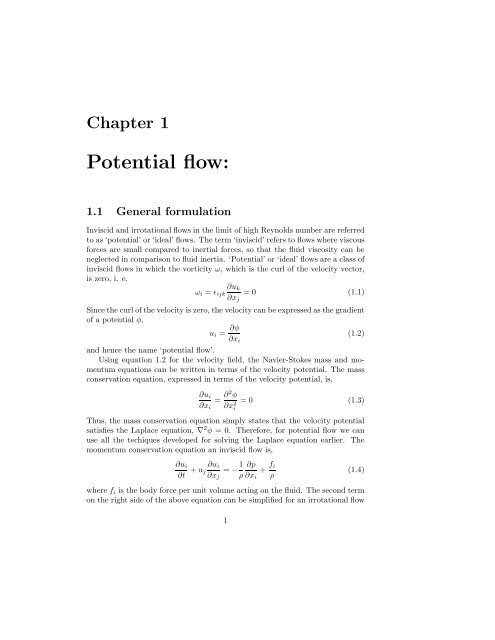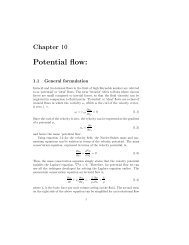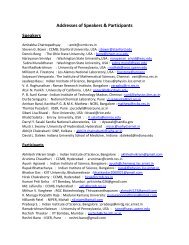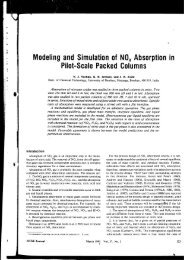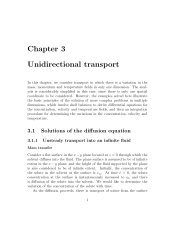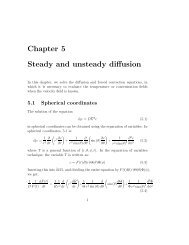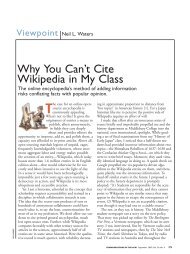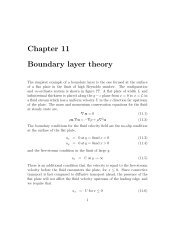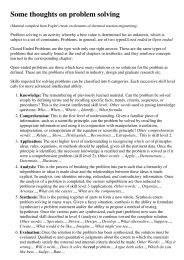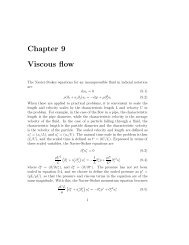Potential flow:
Potential flow:
Potential flow:
You also want an ePaper? Increase the reach of your titles
YUMPU automatically turns print PDFs into web optimized ePapers that Google loves.
Chapter 1<strong>Potential</strong> <strong>flow</strong>:1.1 General formulationInviscid and irrotational <strong>flow</strong>s in the limit of high Reynolds number are referredto as ‘potential’ or ‘ideal’ <strong>flow</strong>s. The term ‘inviscid’ refers to <strong>flow</strong>s where viscousforces are small compared to inertial forces, so that the fluid viscosity can beneglected in comparison to fluid inertia. ‘<strong>Potential</strong>’ or ‘ideal’ <strong>flow</strong>s are a class ofinviscid <strong>flow</strong>s in which the vorticity ω, which is the curl of the velocity vector,is zero, i. e.ω i = ǫ ijk∂u k∂x j= 0 (1.1)Since the curl of the velocity is zero, the velocity can be expressed as the gradientof a potential φ,u i = ∂φ∂x i(1.2)and hence the name ‘potential <strong>flow</strong>’.Using equation 1.2 for the velocity field, the Navier-Stokes mass and momentumequations can be written in terms of the velocity potential. The massconservation equation, expressed in terms of the velocity potential, is,∂u i= ∂2 φ∂x i ∂x 2 = 0 (1.3)iThus, the mass conservation equation simply states that the velocity potentialsatisfies the Laplace equation, ∇ 2 φ = 0. Therefore, for potential <strong>flow</strong> we canuse all the techiques developed for solving the Laplace equation earlier. Themomentum conservation equation an inviscid <strong>flow</strong> is,∂u i∂t + u ∂u ij = − 1 ∂p+ f i∂x j ρ ∂x i ρ(1.4)where f i is the body force per unit volume acting on the fluid. The second termon the right side of the above equation can be simplified for an irrotational <strong>flow</strong>1
1.1. GENERAL FORMULATION 3to satisfy the tangential velocity and stress conditions. This is because we haveneglected the viscous terms in the momentum conservation equation 1.4, whichcontain the second spatial derivatives of the velocity field. Consequently, wehave reduced the equations from a second order to a first order equation inthe spatial coordinates. And therefore, it is possible to satisfy only the normalvelocity and stress boundary conditions at the surface. If we neglect viscouseffects, the only contribution to the stress is the isotropic contribution due tothe pressure,τ ij = −pδ ij (1.12)It should be noted that the Laplace equation 1.3 for the velocity potentialis a linear equation, and if normal velocity boundary conditions are prescribedat the bounding surface, the potential is a linear function of the velocity. If thevelocity of all surfaces is changed by a constant factor, the potential and thevelocity at all points in the fluid also change by the same factor. In addition,the solutions for the velocity potential are ‘quasi-static’ for imposed normalvelocities of the bounding surfaces, because the potential at a given instantin time depend only on the velocity of the bounding surfaces at that instant.However, the Bernoulli equation 1.10 for the pressure is a non-linear equation,since it has a contribution proportional to the square of the velocity, and is alsoexplicitly dependent on time, since it contains a term proportional to the timederivative of the potential. Therefore, the solution for the velocity potentialunder imposed normal stresses at the bounding surfaces is not linear or quasistatic.There are some general results that can be derived for potential <strong>flow</strong>s. Thefirst is that the kinetic energy in a potential <strong>flow</strong> can be expressed as a functionof the potential and normal velocity at the bounding surfaces. The kineticenergy of the fluid in a volume V with bounding surfaces S is defined as,∫KE = ρ 2= ρ ∫2= ρ ∫2VVVdV u 2 j( ) ∂φ ∂φdV∂x j ∂x j( ( ) )∂ ∂φdV− φ ∂2 φ∂x j ∂x j ∂x 2 j(1.13)where integration by parts has been used in the final step. Since the potentialsatisfies the Laplace equation 1.3, the second term in the integrand on the rightside of equation 1.13 is zero, and the expression for the kinetic energy reducesto,KE = ρ ∫dV ∂ ( ) ∂φ2 V ∂x j ∂x j= ρ ∫φu j n j (1.14)2S
4 CHAPTER 1. POTENTIAL FLOW:where n is the outward unit normal at the surfaces bounding the fluid. Therefore,the kinetic energy of the fluid can be expressed only in terms of the potentialand normal velocity at the bounding surfaces. It follows that if the normalvelocity at all bounding surfaces is zero, then the kinetic energy is zero, whichimplies that the fluid velocity is zero throughout the domain.It is possible to prove a ‘uniqueness theorem’ for potential <strong>flow</strong>s, whichstates that the potential <strong>flow</strong> solution is unique if the normal velocity boundaryconditions are specified on all boundaries. To prove this, we first assume thatthe potential <strong>flow</strong> solution is not unique, and that there are two potential <strong>flow</strong>solutions, u and u ∗ , which satisfy the same normal velocity boundary conditions,u i n i = u ∗ i n i on the bounding surfaces of the <strong>flow</strong>. Consider the integral overthe fluid domain V , ∫I = dV (u ∗ i − u i )(u ∗ i − u i ) (1.15)VSince the integrand is always positive, the integral also has to be positive. For apotential <strong>flow</strong>, this integral can be rewritten by expressing the velocity in termsof the velocity potential, and using integration by parts as follows.I ==∫∫VVdV (u ∗ i − u i) ∂(φ∗ − φ)∂x idV ∂∫((u ∗ i∂x − u i)(φ ∗ − φ) −iVdV (φ ∗ − φ) ∂(u∗ i − u i)∂x i(1.16)The second integral on the right side of equation 1.16 is zero due to the incompressibilitycondition, while the first integral can be expressed as a surfaceintegral using the divergence theorem,∫I = dS(φ ∗ − φ)(u ∗ i − u i )n iS= 0 (1.17)Here, we have used the condition that the two velocity fields satisfy the samenormal velocity conditions on the boundaries, so that (u ∗ i − u i)n i is zero on allboundaries.We had earlier assumed that u ∗ and u are different velocity fields, in whichcase the integral I has to be positive. However, we have proved in equation 1.17that I is zero if the normal velocity fields at all surfaces are equal. Therefore,this implies, that it is not possible to have two different potential <strong>flow</strong> solutionswhich satisfy the same normal velocity boundary conditions at all the boundingsurfaces, and the solutions for the potential <strong>flow</strong> equations is unique if the normalvelocity conditions are specified at all boundaries.Another general result is the ‘minimum energy theorem’, which states thatthe kinetic energy of a potential <strong>flow</strong> is less than or equal to the kinetic energyof any other <strong>flow</strong> that satisfies the same normal velocity boundary conditionsat the bounding surfaces. Let us consider two velocity profiles, u i and u ∗ i , bothof which satisfy the same normal velocity boundary conditions at the bounding
1.2. THREE-DIMENSIONAL POTENTIAL FLOWS 7Equation the normal velocity 1.4 to U j n j at the surface r = R, we obtain thesolution A = −(R 3 /2). Therefore, the final solution for the velocity potentialwhich satisfies the boundary conditions at the surface is,φ = − R3 U j x j2r 3 (1.5)It is convenient to express the potential in a spherical co-ordinate system withco-ordinates (r, θ, φ), in which the azimuthal angle θ is measured from the directionof the velocity U. In this co-ordinate system, the potential is independentof the meridional angle, and is given by,φ = − R3 U cos(θ)2r 2 (1.6)The components of the velocity in the r and θ directions are,u r = ∂φ∂r= − R3 U cos(θ)r 3 (1.7)u θ = 1 r∂φ∂θ= R3 U sin (θ)2r 3 (1.8)The total kinetic energy due to the fluid <strong>flow</strong> can be calculated using equation1.14. Note that the unit normal n is the outward unit normal at the boundingsurfaces of the fluid. The integral in equation 1.14 has no contribution due to thesurface at a large distance from the sphere, since the velocity decreases to zero.At the surface of the fluid, the outward unit normal to the fluid is directedinto the sphere, and therefore n i = −(x i /r) at the surface of the sphere. Inaddition, the normal velocity of the fluid at the surface u j n j is equal to thenormal velcoity of the sphere U j n j , and therefore the kinetic energy is given by,∫KE = − ρ 2 S sphere= ρ ∫2 S sphere∫= ρR3 U j U k4dS φU jx jrdS R3 U k x kr 3S sphereU j x jrdS x jx kr 4 (1.9)The surface integral in equation 1.9 can easily be evaluated,∫dS x jx kS rsphere4 = 4π 3(1.10)
8 CHAPTER 1. POTENTIAL FLOW:Therefore the final expression for the kinetic energy due to the fluid motion is,( 2πR 3 )ρ U2jKE =(1.11)3 2If the kinetic energy of due to the moving fluid is expressed as (M a Uj 2 /2), whereM a is the ‘added mass’ which has to be moved in addition to the mass of themoving fluid, then the added mass is given byM a = 2πR3 ρ3(1.12)It can easily be seen that the added mass is equal to half the mass of fluid thatis displaced by the sphere.The pressure exerted on the fluid at the surface of the sphere can be evaluated,( )∂φp = p 0 − ρ∂t + u2 j(1.13)2It is necessary to exercise some care in calculating the time derivative of thepotential in the above equation. Though the velocity of the sphere is a constant,the potential in a fixed reference frame is not a constant. This is because theradius vector from the center of the sphere to a fixed location in space changes asthe sphere moves, and consequently the potential at this location also changes.If x 0 is the location of the center of the particle, and x is the observation point,the equation for the potential 1.2 can be written as,φ = − R3 U j2(x j − x 0j )|x − x 0 | 3 (1.14)Since the sphere is moving with velocity U, the rate of change of potential is,∂φ∂t = ∂φ dU j∂U j dt + ∂φ dx 0k∂x 0k dt(1.15)The derivative of the potential with respect to x 0k can be written as the negativeof the derivative with respect to x k in the above equation, because the potentialis only a function of the distance (x − x 0 ). Therefore, the change in x − x 0due to a displacement of ∆x in the position x 0 is identical to that due to adisplacement of −∆x in the position x. Therefore, (∂φ/∂x 0k ) = −(∂φ/∂x k ),and equation 1.16 reduces to,∂φ∂t= ∂φ∂U jdU jdt − ∂φ∂x kU k= ∂φ∂U jdU jdt − U ku k (1.16)This is inserted into the equation for the pressure to obtain,( )u2jp = p 0 − ρ2 − u ∂φ dU jjU j∂U j dt(1.17)
1.2. THREE-DIMENSIONAL POTENTIAL FLOWS 9In the above equation, we have returned to a co-ordinate system in which theorigin is located at the center of the particle. The radial component of the fluidvelocity, u r , at the surface is zero, and the only contribution to the kinetic energyis due to the tangential velocity at the surface, u θ (equation 1.8). Therefore,the pressure at the surface r = R is given by,( u2p = p 0 − ρ θ2 + U sin (θ)u θ − R cos(θ) dUdt)= p 0 − ρU 2 (5 sin (θ) 216− R U 2 cos(θ)dU dt)(1.18)In equation 1.19, we have substituted U θ = −U sin (θ) and u θ = (U sin (θ)/2)at r = R.The force exerted on the sphere can be calculated by integrating the pressureover the surface of the sphere,∫F i = dSτ ij n jS sphere∫= dSpn i (1.19)S sphereBy symmetry, the force perpendicular to the velocity is zero. The force alongthe direction of the velocity is,∫F z = dSpn z (1.20)S spherewhere F z is the force in the direction of the velocity vector, and n z is thecomponent of the unit normal to the sphere in the direction of the velocityvector. For the steady <strong>flow</strong> of a particle with (dU/dt) = 0, it can easily beshown that the force F i is identically zero due to symmetry considerations. Thepressure p is a symmetric function of θ about the mid-plane cutting the sphereperpendicular to the direction of <strong>flow</strong> at θ = (π/2). However, the unit normaln z = cos(θ) is anti-symmetric about the plane θ = (π/2), and therefore theintegral of the pressure and n z over the surface of the sphere is identically zero.This result, that the steady motion of a sphere through a fluid does not exert aforce on the fluid, is referred to as ‘d’Alembert’s paradox’.If the particle is accelerating, there is a net force exerted on the particle bythe fluid. This is calculated by integrating the contribution to the pressure dueto acceleration over the surface of the sphere.∫F i = ρS sphere= ρ ∫dU j2R dt( R 3 ) ∣ x j dU j ∣∣∣∣r=RdSn i2r 3 dtdSx i x jS sphere
10 CHAPTER 1. POTENTIAL FLOW:=( 2πR 3 ρ3= M bdU idt) dUidt(1.21)Here, the outward unit normal to the sphere is given by n i = (x i /r), and wehave used the identity∫dSx i x j = 4πR4 δ ij(1.22)S 3sphereto obtain the third step in equation 1.22. Not surprisingly, the force requried toaccelerate the particle through the fluid is the product of the added mass andthe acceleration.1.2.2 General three-dimensional potential <strong>flow</strong>s:Some general results can be obtained for the form of the velocity potential for anobject of arbitrary shape translating through a fluid in potential <strong>flow</strong>. The solutionfor the velocity potential is, in general, more complicated than the solution1.6 for the motion of a sphere. However, the leading contribution to the potentialis still the dipole contribution which decays proportional to (1/r 2 ) in threedimensions. There is no source term proportional to (1/r) due to the incompressibilitycondition and the constant volume of the object. However, higherorder terms which decay faster than (1/r 2 ) could be present in the solution.Equation 1.18 for the pressure is valid for an object of arbitrary shape, sinceno assumption was made regarding the specific form of the velocity potentialwhile deriving the pressure.It is possible to show that the force required for the steady motion of anobject of arbitrary shape through the fluid,∫F i = dSpn iS object∫ ( )u2j= ρ dSn i S 2 − U ju j (1.1)objectis equal to zero. Consider the volume integral∫VdV ∂∂x i(u2j2 − U ju j)(1.2)evaluated over the volume of the fluid surrounding the fluid. Using the divergencetheorem, this volume integral can be written as,∫ ( )dV ∂ u2 ∫ ( )ju2 ∫ ( )V ∂x i 2 − U ju2ju j = dSn iS ∞2 − U jju j − dSn i S 2 − U ju jobject
1.3. TWO-DIMENSIONAL POTENTIAL FLOWS: 11∫S ∞dSn i(u2j2 − U ju j)− F i (1.3)The volume integral on the left side of equation 1.3 can further be simplified asfollows,∫VdV ∂∂x i(u2j2 − U ju j)===∫∫∫VVVdV (u j − U j ) ∂u j∂x idV (u j − U j ) ∂u i∂x jdV ∂∂x j((u j − U j )u i ) (1.4)In the second step of the above equation, we have used the fact that the stresstensor is symmetric for an irrotational <strong>flow</strong>, so that (∂u i /∂x j ) = (∂u j /∂x i ). Inthe final step, we have used the incompressibility condition (∂u j /∂x j ) = 0. Thevolume integral in equation 1.4 can further be converted into a surface integralby first using the incompressibility condition∫VdV ∂∂x j((u j − U j )u i ) =∫∫dSn j (u j − U j )u i −S ∞ S objectdSn j (u j − U(1.5)j )u iIn the final step of the above equation, we have used the normal velocity boundarycondition, u j n j = U j n j on the surface of the object, so that the integralover the surface of the object is zero. Equating the right sides of equation 1.3and 1.6, the force on the object can be expressed as,∫ ( ( ))u2jF i = dS n iS ∞2 − U ju j − n j (u j − U j )u i (1.6)The right side of the above equation contains terms that are linear or quadraticin the velocity, and the integral is evaluated at a large distance from the objectin the limit r → ∞. In this limit, the velocity decreases proportional to (1/r 3 ),whereas the surface area increases proportional to r 2 . Therefore, both the integralson the right side are zero in the limit r → ∞. This shows that the forceon an object of arbitrary shape is zero in a potential <strong>flow</strong>.1.3 Two-dimensional potential <strong>flow</strong>s:The analysis of potential <strong>flow</strong>s in two dimensions is considerably simplified bythe use of complex functions. The simplification is due to two important propertiesof complex functions.1. If a complex function F(z) of a complex variable z is analytic, i. e. thechange in the function DeltaF due to a small change in the variable ∆z
12 CHAPTER 1. POTENTIAL FLOW:can be expressed as∆F = dF ∆z, (1.1)dzthen the real and imaginary parts of the complex function satisfy theLaplace equation in the complex plane. Since the velocity potential is alsoa solution of the Laplace equation, we can associate the real parts of allcomplex functions to the velocity potential. Thus, there is a potential <strong>flow</strong>field associated with all complex functions subject to the normal velocityboundary condition at the surfaces.2. A transformation, called a conformal mapping, can be effected from theindependent complex variable z to some other variable z ′ in such a waythat the function F(z ′ ) also satisfies the Laplace equation in the z ′ plane.In this way, it is possible to map the <strong>flow</strong> in a complicated domain ontothe <strong>flow</strong> in a much simpler domain, and solve the Laplace equation in thesimpler domain.Both the above properties, and their application to two-dimensional complex<strong>flow</strong>s, will be explained in this section.First, we will show that if the if a complex function is analytic, then the realand imaginary parts satisfy the Laplace equation. Consider a complex functionF(z) which is a function of the independent variable z = x+ıy, where ı = √ −1.The function can be written as the sum of its real and imaginary parts,F(z) = φ(x, y) + ıψ(x, y) (1.2)The variation in the function F when the independent variable z is displacedby ∆z = ∆x + ı∆y is,( ) ( )∂φ∂φF(z + ∆z) − F(z) =∂x + ı∂ψ ∆x +∂x ∂y + ı∂ψ ∆y∂y( ) (∂φ=∂x + ı∂ψ ∆x + −ı ∂φ∂x ∂y + ∂ψ )ı∆y (1.3)∂yThe function is analytic if the variation ∆F is proportional to ∆z in the limit∆z → 0, or if ∆F can be written as,∆F = dF ∆z (1.4)dzTherefore, for an analytic function, the real and imaginary parts of the coefficientsof ∆x and ı∆y in equation 1.3 are equal, and the functions φ and ψ havethe relations,∂φ∂x = ∂ψ∂y(1.5)∂ψ∂x= − ∂φ∂y(1.6)
1.3. TWO-DIMENSIONAL POTENTIAL FLOWS: 13The above conditions are referred to as the ‘Cauchy Reimann’ conditions for theanalyticity of a complex function. If we sum the partial derivative of equation1.5 with respect to x and the partial derivative of equation 1.6 with respectto y, we find that the function φ(x, y) satisfies the Laplace equation in twodimensions,∂ 2 φ∂x 2 + ∂2 φ∂y 2 = 0 (1.7)Similarly, if we take the difference of the partial derivative of equation 1.5 withrespect to y and equation 1.6 with respect to x, we find that the function ψ alsosatisfies the Laplace equation in two dimensions,∂ 2 ψ∂x 2 + ∂2 ψ∂y 2 = 0 (1.8)Therefore, if a complex function F(z) is analytic, then its real and imaginaryparts satisfy the Laplace equation.Since the real part φ(x, y) of any complex function F(z) is a solution ofthe Laplace equation 1.7, it is also a valid solution for the velocity potential ina two dimensional domain provided it satisfies the normal velocity boundaryconditions at the prescribed boundaries. Thus, every complex function has atwo dimensional velocity field associated with it that satisfies the potential <strong>flow</strong>equations. The velocities in the x and y direction are then given by,u x = ∂φ∂x = ∂ψ∂yu y = ∂φ∂y = −∂ψ ∂x(1.9)where the Cauchy-Reimann conditions have been used to express derivativesof the potential φ in terms of derivatives of the imaginary part ψ. It is clear,from the relations 1.9 between u x , u y and ψ, that the imaginary part ψ is thestream function for the <strong>flow</strong>. Thus, the real and imaginary parts of the complexpotential are the velocity potential and the stream function respectively. Thefunction F(z) is often referred to as the ‘complex potential’. The derivative ofF(z) with respect to z can be written as,W(z) =dFdz= ∂φ∂x + ı∂ψ ∂x= u x − ıu y (1.10)It is also convenient to express the function W(z) in terms of the components(u r , u θ ) in a polar co-ordinate system. The relation between the velocities in aCartesian and polar co-ordinate systems are,u x= u r cos(θ) − u θ sin(θ)u y = u r sin (θ) + u θ cos(θ) (1.11)
14 CHAPTER 1. POTENTIAL FLOW:Using these it can easily be verified that the complex potential is,W(z) = (u r − ıu θ )exp (−ıθ) (1.12)Since we have shown that there are potential <strong>flow</strong> velocity fields associatedwith any analytic complex function, we can examine the potential <strong>flow</strong> fieldsdue to some fundamental forms of the function F(z). We first consider the form,F(z) = Az m (1.13)where A is assumed to be real without loss of generality. The derivative of F(z)with respect to z is,W(z) =dFdz= mAz m−1= mAr m−1 exp (ı(m − 1)θ) (1.14)Comparing the form of W(z) in equation 1.14 with that in equation 1.12, wefind that the velocities u r and u θ in a polar co-ordinate system are,u r = Ar m−1 cos(mθ)u θ = Ar m−1 sin (mθ) (1.15)Equations 1.15 represent a <strong>flow</strong> that, for positive A, is directed radially outwardfor θ = 0, radially inward for θ = (π/m), and along the θ co-ordinate forθ = (π/2m), as shown in figure ??. Since the normal velocity is zero along thelines θ = 0 and θ = (π/m), the velocity field 1.15 represents the <strong>flow</strong> in a cornerof subtended angle (π/m). Several special cases can be considered for specificvalues of m. For m = 1, the subtended angle is π, and the <strong>flow</strong> is a steadylinear <strong>flow</strong> with velocity A in the x direction, as shown in figure ??. The <strong>flow</strong>for m = 2 is the stagnation point <strong>flow</strong> in a corner of angle (π/2), as shown infigure ??. The <strong>flow</strong> for m > 2 is the <strong>flow</strong> in a corner with a subtended acuteangle, while the <strong>flow</strong> for 1 < m < 2 is the <strong>flow</strong> in a corner with a subtendedobtuse angle, as shown in figure ??.Next, we consider the formF(z) = m log (z) (1.16)2πwhere m is a real constant. The derivative of F(z) with respect to z is,W(z) =m2πz= m exp (−ıθ) (1.17)2πrComparing equation 1.17 with 1.12, we find that the components of the velocityfield are,u r = m2πru θ = 0 (1.18)
1.3. TWO-DIMENSIONAL POTENTIAL FLOWS: 15This is the <strong>flow</strong> from a point source of fluid in two dimensions, from which thetotal volume of fluid generated (per unit length in the third dimension) Q atany radius R is equal to m, and is independent of radius.A logarithmic function with an imaginary coefficient represents circulationabout the origin. Consider the form,F(z) =where Γ is real. The derivative of F(z) is,ıΓ log (z) (1.19)2πW(z) = − ıΓ2πz= − ıΓ exp (−ıθ)2πr(1.20)Comparing equation 1.20 with equation 1.12, we find the components of thevelocity,u r = 0u θ =Γ2πr(1.21)Thus, the <strong>flow</strong> due to the potential 1.21 is a circulating <strong>flow</strong> around the origin.For this <strong>flow</strong>, the circulation is the integral of the tangential velocity along aclosed curve around the origin, is equal to Γ.Circulation =1.3.1 Flow around a cylinder∫ 2π0rdθu θ= Γ (1.22)The motion around a cylinder translating with a velocity U x in the x directionin a fluid which is at rest at a large distance from the cylinder is expressed bya complex potential of the form,F(z) = − U xR 2z− ıΓ log (z) (1.1)2πThe velocity fields can be inferred from the derivative of this complex potentialwith respect to z,W(z) =dFdz= U xR 2z 2 − ıΓ(2πzUx R 2=r 2exp(−ıθ) − ıΓ2πr)exp(−ıθ) (1.2)
16 CHAPTER 1. POTENTIAL FLOW:The radial and polar components of the velocity can be inferred using equation1.12,u r = U xR 2cos(θ)r 2u θ = U xR 2r 2sin (θ) + Γ2πr(1.3)The above velocity field satisfies the condition u i n i = U i n i at the surface ofa cylinder with radius R, since the normal velocity u i n i , which is the radialvelocity u r in a polar co-ordinate system, is equal to U i n i = U x n x = U x cos(θ),where the component n x of the unit normal to the surface is equal to cos(θ).The force on the cylinder can be determined from the equation 1.17 for theforce on an object moving with velocity U i through the fluid,∫F i = ρ= ρS object∫ 2π0dSn i(u2j2 − U ju j)( )∣ u2 ∣∣∣r=R(Rdθ) n θ i2 − U x(u r cos(θ) − u θ sin (θ) (1.4)The ‘drag’ force F x , which is in the direction of the velocity, can be determinedusing n x = cos(θ) in equation 1.4,F x = ρ= ρ∫ 2π0∫ 2π0(Rdθ)cos(θ)(Rdθ)cos(θ)(12(12(U x sin (θ) + Γ2πR(U x sin (θ) + Γ2πR) 2+ U x (u r cos(θ) + u θ sin(θ)))) 2+ U 2 x(cos(θ) 2 − sin(θ) 2))= 0 (1.5)As in three dimensions, the drag force due to the potential <strong>flow</strong> in two dimensionsis also equal to zero. The ‘lift’ force perpendicular to the direction of gravitycan be determined using n y = sin(θ) in equation 1.4,F x = ρ∫ 2π0(Rdθ)sin (θ)( (1U x sin (θ) + Γ ) 2+ Ux (cos(θ) 2 2 − sin (θ) 2))2 2πR= ρU x Γ (1.6)1.4 Force on a two-dimensional object of arbitraryshape:The net force exerted on a two-dimensional object in potential <strong>flow</strong> can becalculated in a manner similar to that for a three-dimensional <strong>flow</strong>. A procedure
18 CHAPTER 1. POTENTIAL FLOW:3. Determine the energy dissipation due to the motion of a sphere at highReynolds number, assuming that the fluid velocity field is given by thepotential <strong>flow</strong> solution. Using this, find the drag force on the sphere. Howdoes it compare to the drag force on a sphere at zero Reynolds number?The rate of dissipation of energy is given by,∫D = dV µ(∇u:∇u)4. Consider a bubble with internal pressure p b expanding in a fluid in whichthe pressure a large distance from the bubble is p 0 . The radius of thebubble R(t) is a function of time as it expands.(a) Solve the potential <strong>flow</strong> equations to determine the fluid velocity fielddue to the expanding bubble.(b) Determine the pressure at the surface of the bubble.(c) Form a pressure balance condition, find the equation for the evolutionof the bubble radius.5. Consider two line sources of strength −m and m separated by a distanced along the x axis, in a fluid <strong>flow</strong>ing with a constant velocity U in thex direction. What is the equation for the shape of the object which isequivalent to these two sources? Show that in the limit d → 0 and (md)finite, the object assumes the shape of a cylinder, and find its radius.6. Consider the transform from the z to the z ′ plane given byz = z ′ + a2z ′(a) Determine the relations between the coordinates (x ′ , y ′ ) and (x, y).(b) Consider a circle of radius a in the z ′ plane. What is the transformedshape in the z plane? If we consider the <strong>flow</strong> past the cylinder in thez ′ planeF(z ′ ) = z ′ + a2z ′in the z ′ plane, what is the equivalent <strong>flow</strong> in the z plane?(c) Consider a circle of radius b > a in the z ′ plane. What is the transformedshape in the z plane? If we consider the <strong>flow</strong> past the cylinderin the z ′ planeF(z ′ ) = z ′ + b2z ′in the z ′ plane, what is the equivalent <strong>flow</strong> in the z plane?
1.4. FORCE ON A TWO-DIMENSIONAL OBJECT OF ARBITRARY SHAPE:197. A three dimensional irregular body is moving with a velocity U 1 in the x 1direction near a wall which is perpendicular to the x 2 axis as shown in thefigure. The Reynolds number is large so that the potential <strong>flow</strong> equationsare applicable. The wall is impermeable so that the fluid <strong>flow</strong> at the wallis tangential to it. Find the force on the body in the x 1 and x 2 directionsas a function of the velocity of the object U 1 and the fluid velocity at thewall.(Hint: Consider a control volume bounded by the surface of the objectS, the surface of the wall S w and the surface at infinity S ∞ . Use methodssimilar to the derivation of the d’Alembert paradox for a general body inirrotational <strong>flow</strong>.)8. Consider the dynamics of waves on the surface of a liquid of wavelengthλ, frequency ω and amplitude ξ 0 . Find the conditions (at high Reynoldsnumber) under which the u j ∂ j u i term in the momentum conservationequation can be neglected compared to the ∂ t u i term. Under these conditions,find the frequency of the surface waves on the surface of a liquidof infinite depth as a function of the wavelength of the waves. The heightof the surface fluctuations is given by the equation:ξ = ξ 0 exp(ikx + iωt)where k = (2π/λ) is the wave number, and ω is the frequency of the waves.In addition, the normal velocity at the surface z = 0 is given by the timerate of change of the displacement ξ.


